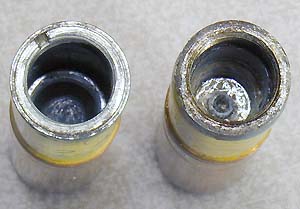| The "Miné" Shell
The Mine (“min-ee”) shell was developed in Germany during WWII for small
caliber cannon in order to maximize the destructive effect against aircraft
targets, specifically bombers.
The round at left is a Miné projectile, at right, a forged round. |

Note the end of the tracer element extending into the explosive cavity of the forged one. This is one form of a self destruct feature. Miné rounds were not usually made as tracer types, the base of the projectile was hollowed out as much as possible to maximize explosive content. The self destruct feature for Miné shells used a special "spin-decay" type nose fuze. |